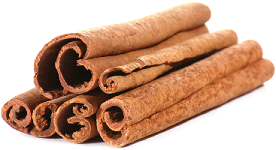- Cassia is an aromatic bark, similar to cinnamon, but differing in strength and quality. Its bark is darker, thicker and coarser, and the corky outer bark is often left on. The outer surface is rough and grayish brown, the inside bark is smoother and reddish-brown. It is less costly than cinnamon and is often sold ground as cinnamon. When buying as sticks, cinnamon rolls into a single quill while cassia is rolled from both sides toward the centre so that they end up resembling scrolls. cassia budsCassia buds resemble cloves. They are the dried unripe fruits about 14 mm (1/2 in) long and half as wide. It is native to Burma and grown in China, Indo-China, the East and West Indies and Central America. It is called kwei in the earliest Chinese herbal by Shen-nung (2700 B.C.). It reached Europe in classical times with Arabian and Phoenician traders and the buds were known in Europe in the Middle Ages.
Contents
Uses
- Cassia cinnamon is used for gas (flatulence), muscle and stomach spasms, preventing nausea and vomiting, diarrhea, infections, the common cold, and loss of appetite.
- Some people use it for erectile dysfunction (ED), hernia, bed-wetting, joint conditions, menopausal symptoms, menstrual problems, and to cause abortions.
- Cassia cinnamon is also used for chest pain, kidney disorders, high blood pressure, cramps, cancer, and as a “blood purifier.”
- Cassia cinnamon is used in suntan lotions, nasal sprays, mouthwashes, gargles, toothpaste, and as a “counter-irritant” applied to the skin in liniments. A counter-irritant is a substance that creates pain and swelling at the point of application with the goal of lessening pain and swelling at another location.
- In food and beverages, cassia cinnamon is used as a flavoring agent.
Benefits
- Cassia cinnamon contains the chemical cinnamaldehyde, which might have activity against bacteria and fungi.
Cautions
- Cinnamon usually causes no side effects. Heavy use of cinnamon may irritate the mouth and lips, causing sores. In some people, it can cause an allergic reaction. Applied to the skin, it might cause redness and irritation.
- Very high quantities of cassia cinnamon may be toxic, particularly in people with liver problems. Because cinnamon may lower blood sugar, people with diabetes may need to adjust their treatment if they use cinnamon supplements. *An ingredient in some cinnamon products, coumarin, may cause liver problems. Given the lack of evidence about its safety, cinnamon — as a treatment — is not recommended for children or for women who are pregnant or breastfeeding.
- Dosing: Very high doses may be toxic.Because cinnamon is an unproven treatment, there is no established dose. Some recommend 1/2 to 1 teaspoon (2-4 grams) of powder a day. Some studies have used between 1 gram and 6 grams of cinnamon.
References
Source: WebMD, “Cassia Cinnamon”. www.webmd.com/vitamins-supplements/
For More Information See: Cinnamon

